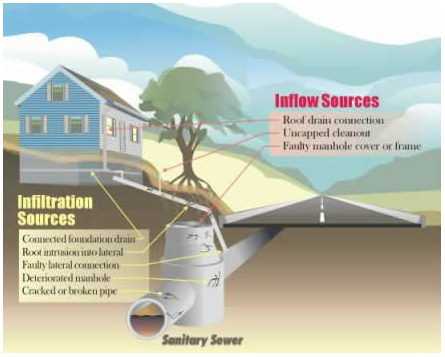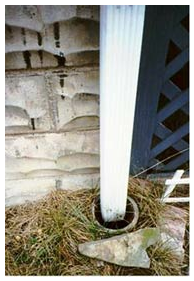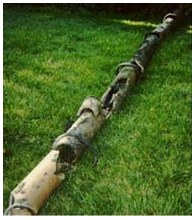
Unlike water pipes, always full because of the pressure used to deliver water into homes, sewer pipes are rarely full when wastewater is flowing from homes to the sewage treatment plant. When water pipes break, crack or are broken, they leak water out; sewer systems, on the other hand, allow groundwater and stormwater to leak in.
When groundwater or stormwater leak into the sewer system, it takes up extra space that could be carrying wastewater. If the pipes become overloaded, raw sewage may overflow at points throughout the sewer system before it reaches the treatment plant.

Inflow and infiltration are terms used to describe how stormwater and groundwater get into the sewer system.
Inflow is stormwater that is directly piped into a sewer system from runoff. These connections, which may include storm drains in streets, parking lots, driveways and roof gutters, exist in a combined sewer system because it is designed to carry both wastewater and stormwater. Stormwater should never be connected into a sanitary system designed to carry only wastewater.
Some examples of the way inflow affects a sanitary sewer system:
 Example of inflow: A downspout connected directly to the sanitary sewer system.
Example of inflow: A downspout connected directly to the sanitary sewer system.
Infiltration is excess water that gets into the sewer system through open joints, cracks, and breaks in the pipes. These deficiencies may allow constant infiltration of groundwater. The design life of a sewer pipe is about 50 years, depending on the material and quality of installation. In many cases throughout the Southwestern Pennsylvania region, collection system pipes and household laterals have gone much longer without inspection or repair and are likely to be cracked or broken.
Some examples of the way infiltration affects the sewer system:
 Example of infiltration: A deteriorated house lateral that allowed water to seep into the sewer collection system.
Example of infiltration: A deteriorated house lateral that allowed water to seep into the sewer collection system.
Inflow and infiltration play a significant role in the sewage overflow problem. During dry weather, about 40% of all flow that reaches the ALCOSAN treatment plant is due to inflow and infiltration of stormwater and groundwater. The EPA estimates that up to 50% of the I/I problem may be due to problems with house laterals.
During wet weather, inflow and infiltration can add as much as 3,000 gallons of stormwater per person per day to the sewers, instead of the average daily 100 gallons per person of water use that is typical during dry weather. That's an overload of 30 times more flow per day during rain or snow melt, which then causes sewage to overflow into creeks, streams and rivers at hundreds of locations throughout Allegheny County before reaching the sewage treatment facility.
When an overflow occurs in a separate sanitary sewer system, it is called a sanitary sewer overflow (SSO). This may occur at an overflow structure, into a street from a manhole cover or into the basement of homes. Overflow structures, which were legal at the time of construction, and unintentional SSOs both are illegal in separate sanitary sewer systems under the Federal Clean Water Act.
In a combined sewer system, overflows are called combined sewer overflows (CSO). Because combined sewer systems are intended to carry stormwater and wastewater, they were designed with structures to deliberately release excess flow when the system becomes overloaded, only during wet weather. While overflow structures in combined sewer systems are legal, municipalities must acquire a permit for each structure and very soon will need to dramatically decrease the volume and frequency of CSOs that occur annually. CSOs may also occur at unintended locations, such as manholes and basements. Like SSOs, these types of CSOs are illegal.
While every community is likely to experience at least a few overflows in their sewer system, the older communities located in downstream valleys experience the most overflows and basement backups due to their low location in the watershed. The sewer collection systems in these communities not only carry their own sewage (and in many cases stormwater), but they often receive the wastewater flow from their neighboring communities upstream. The complex network of integrated sewer collection system pipes throughout the ALCOSAN service area makes it critical for all municipalities to collaborate on and share the responsibility for developing and implementing long-term solutions to the overflow problem.